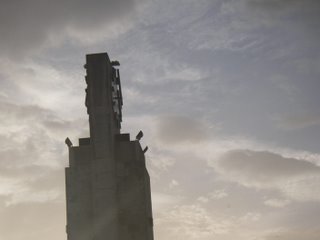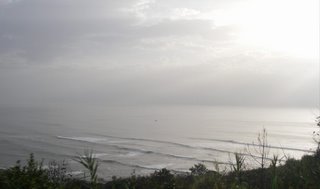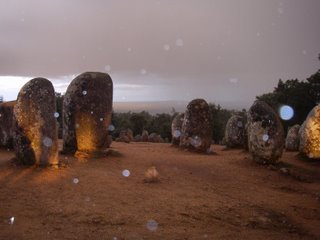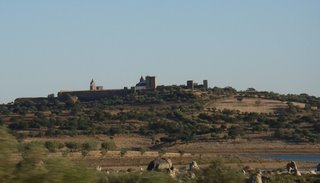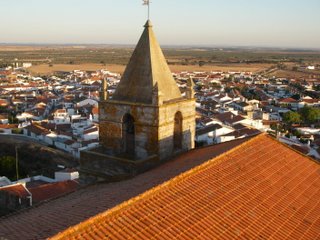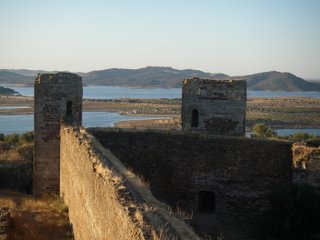Its that time of year

First - Happy Christmas to all of you, even randoms happening on this by chance, from Bry and I. Hope 2007 is spectacular for you and we both hope we'll see you somewhere, sometime during it. Also congratulations to my most random internet stalker who is expecting twins next year.
Christmas has snuck up on me this year - two long weekends in row courtesy of Portuguese public holidays have distracted from it as well as having a lot on my plate. I have been flat tack busy as you might have guessed from the last month or so being filled with posts about nothing, or full of photos. But all of a sudden the Christmas lights are up (Montemor this year beat Escoural by two weeks or so to put the lights up) and I'm sitting here with everything ticked off in my diary and a hangover from last night's Christmas dinner.
So I am seriously looking forward to a break, a holiday and relaxing with friends. I don't need to say that "I'm looking forward to seeing Bry" is an understatement! but interestingly as much as I'm looking forward to seeing somewhere new again I'm more looking forward to the break and spending time with those I care about. When I planned Christmas away last year I didn't feel that so much but this year everyone seems to be heading back and there has been a touch of "maybe I should've headed home". By the same token home is always there and as much as I miss everyone in Perth I know I will be back there soon enough.
Introspection has been the order of the day for the last couple of months as well with the onset of winter and days spent inside. Rain and cold brings a certain grey to anyone's mood at this time of year plus I seem to have the happy knack of getting sick. Life wasn't like this when I was working "endless summer" in WA. It's also been frustrating work-wise looking out the window and seeing grey drizzle as even though we have achieved so much in terms of compiling data, modelling resources, reviewing prospects/projects etc. etc. in the last couple of months you never feel like you're working unless you're breaking rocks or drilling holes. My fieldies feel it most, forced to pace outside the shed and left to bicker amongst themselves.
The rain brings on other emotions too - as soon as there is a sunny day, or even just a sunny afternoon, you get possessed with a mania to seize the moment, to take advantage of the sun, even though you have a million things on the computer to finish, or should really stay in bed to kick your flu. Which then leads to self-loathing if you don't do something! The rain does add a certain amount of scenery though - everything being so so green and a times a soft mist over the landscape.
OK enough talking. Beijinhos e abracos a tudos e falamos a Ano Novo. Boas Festas!


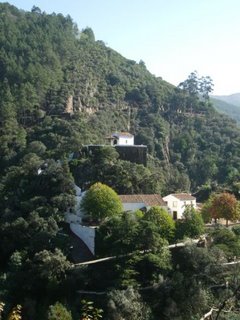 After lunch we visited Portugal's university town -
After lunch we visited Portugal's university town - 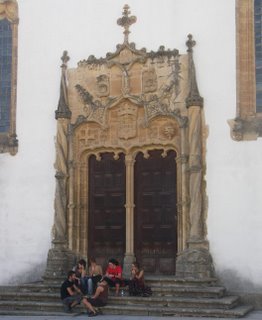 The university was founded in 1290 but it was the capital of Portugal before then and half a dozen kings were born here. Most of them have statues littered around the university campus to impress you the visitor (or scare the students/lecturers into loyalty?). Joao the V went one better and built a library - not that impressive at most univesities but they appear to design libraries differently here. To start there's a piano at one end?! Plus I think there is more gold around the walls here than in the chapel, as well as more painted ceilings (3). My neck is still sore from looking up gawping.
The university was founded in 1290 but it was the capital of Portugal before then and half a dozen kings were born here. Most of them have statues littered around the university campus to impress you the visitor (or scare the students/lecturers into loyalty?). Joao the V went one better and built a library - not that impressive at most univesities but they appear to design libraries differently here. To start there's a piano at one end?! Plus I think there is more gold around the walls here than in the chapel, as well as more painted ceilings (3). My neck is still sore from looking up gawping. This is the chemistry building - very impressive compared to UWA's steel and glass nightmare. For a number of years the university resisted changing the course structures or upgrading facilities, preferring to rely on reputation and quality of teaching. When other universities took the lead in terms of facilities and technology the university found that while these old buildings are pretty they're also pretty costly to keep, let alone upgrade. So a lot of lecturing and teaching is done in newer buildings away from the old campus/town centre.
This is the chemistry building - very impressive compared to UWA's steel and glass nightmare. For a number of years the university resisted changing the course structures or upgrading facilities, preferring to rely on reputation and quality of teaching. When other universities took the lead in terms of facilities and technology the university found that while these old buildings are pretty they're also pretty costly to keep, let alone upgrade. So a lot of lecturing and teaching is done in newer buildings away from the old campus/town centre.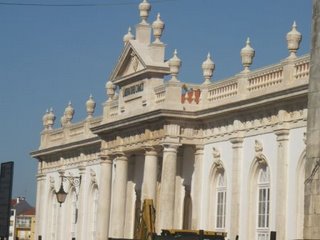
 The new Cathedral was orginally a Jesuit church founded in 1541 but became the cathedral in 1759 when the Prime Minister expelled the Jesuits. The old Romanesque cathedral still survives to this day but its facade is less impressive since soft shaley limestones were used in it's constructions and erosion has left much of the detail obliterated (faceless saints aren't very sacred it seems).
The new Cathedral was orginally a Jesuit church founded in 1541 but became the cathedral in 1759 when the Prime Minister expelled the Jesuits. The old Romanesque cathedral still survives to this day but its facade is less impressive since soft shaley limestones were used in it's constructions and erosion has left much of the detail obliterated (faceless saints aren't very sacred it seems).

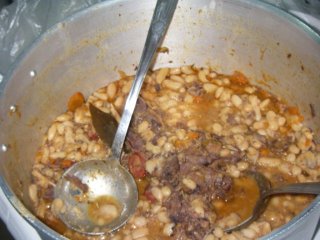
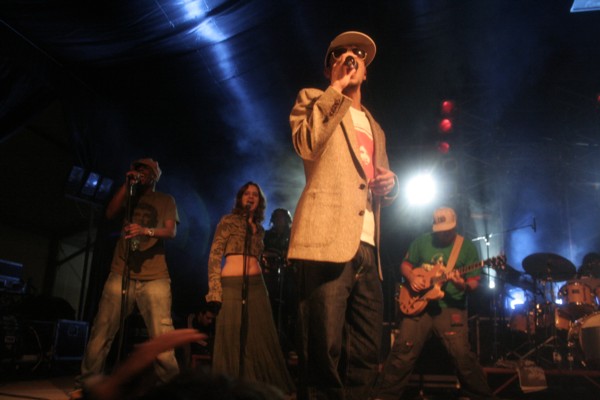

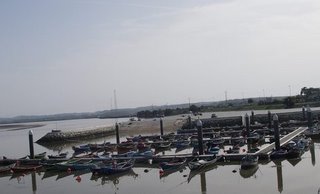
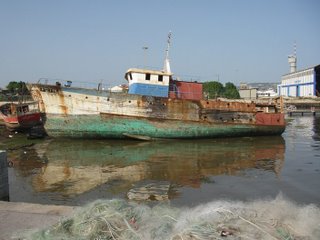
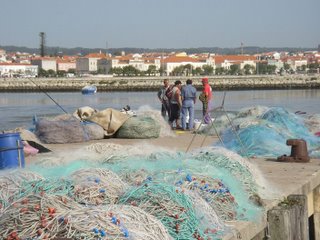
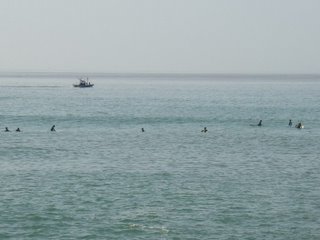
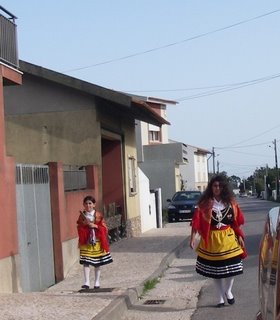


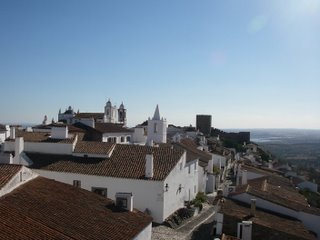
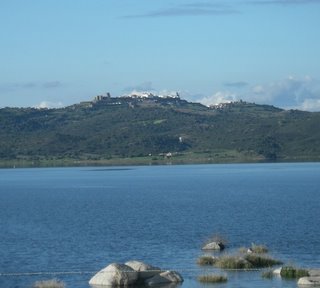
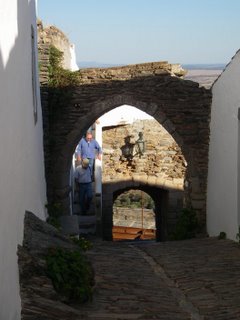



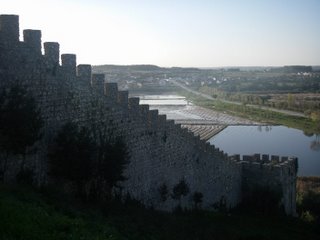
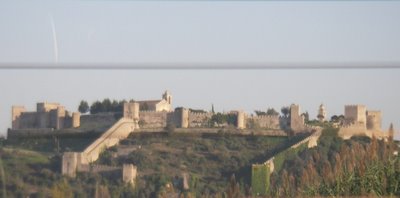
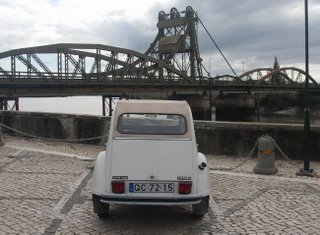 I've blogged about Alcacer do Sal briefly
I've blogged about Alcacer do Sal briefly 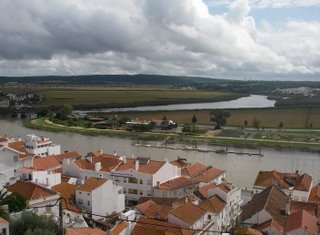 If one photograph can sum up a country this is it. Portugal in a picture: washing outside the windows, wrought iron balconies, tiled exterior, in the background the belltowers of a church and (harder to see) centre right in the shade the shield of the town on the corner of the building, below it a Delta coffee sign outside a ground floor cafe.
If one photograph can sum up a country this is it. Portugal in a picture: washing outside the windows, wrought iron balconies, tiled exterior, in the background the belltowers of a church and (harder to see) centre right in the shade the shield of the town on the corner of the building, below it a Delta coffee sign outside a ground floor cafe.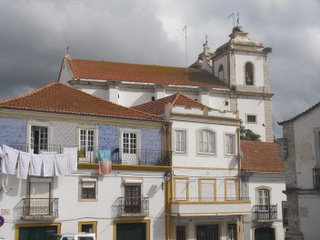 Another slice of normal life: When you visit Alcacer you will inevitably stop for a coffee on the street/esplanade next to the river, if not a few beers as the sun sinks into a cool evening, and more than likely you'll take a walk along the riverside. As you walk watch out for these old ladies hawking little shrimps from the estuary (fresh? who knows) to passers-by, in-between catching up on town gossip.
Another slice of normal life: When you visit Alcacer you will inevitably stop for a coffee on the street/esplanade next to the river, if not a few beers as the sun sinks into a cool evening, and more than likely you'll take a walk along the riverside. As you walk watch out for these old ladies hawking little shrimps from the estuary (fresh? who knows) to passers-by, in-between catching up on town gossip. 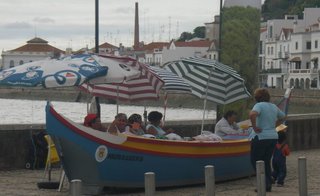 This is the town from the other side of the river crossed by the pedestrian bridge on the left reminiscent of London's Millenium Bridge. The town hall and town square is typical Manueline while the castle on the hill is 5000 years old. The main part of the castle has been restored using new style crappy cement and converted into a hotel/pousada so is more photogenic from a distance, the belltower remains authentic but is surrounded by power lines and full of graffiti from the locals who seem to have tagged it as a hangout.
This is the town from the other side of the river crossed by the pedestrian bridge on the left reminiscent of London's Millenium Bridge. The town hall and town square is typical Manueline while the castle on the hill is 5000 years old. The main part of the castle has been restored using new style crappy cement and converted into a hotel/pousada so is more photogenic from a distance, the belltower remains authentic but is surrounded by power lines and full of graffiti from the locals who seem to have tagged it as a hangout. 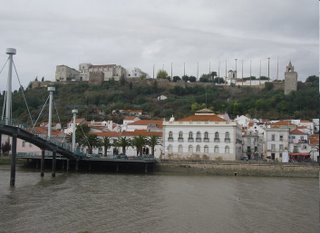 The church you can see between them would've been behind the old town walls and is a 12th Century church with a Romanesque arch (unusual in Portugal). The interior contains the graves of the local noblility, and records of visits by the royal family since the Dukes of Alcacer were cousins to the royal line and fairly important during this time. It also contains a lot of gold!
The church you can see between them would've been behind the old town walls and is a 12th Century church with a Romanesque arch (unusual in Portugal). The interior contains the graves of the local noblility, and records of visits by the royal family since the Dukes of Alcacer were cousins to the royal line and fairly important during this time. It also contains a lot of gold! 
 We stood in line until tickets sold out then spent a couple of hours standing at the gate watching keenly for scalpers or people with extras. One of the advantages of people visiting is that I learn to apply Portuguese in different situations so I can now beg, haggle and scalp tickets :) After a complicated deal involving buying two grandstand tickets then onselling a standing room ticket (all at face price so no actual scalping - bizarre!) we were in!
We stood in line until tickets sold out then spent a couple of hours standing at the gate watching keenly for scalpers or people with extras. One of the advantages of people visiting is that I learn to apply Portuguese in different situations so I can now beg, haggle and scalp tickets :) After a complicated deal involving buying two grandstand tickets then onselling a standing room ticket (all at face price so no actual scalping - bizarre!) we were in!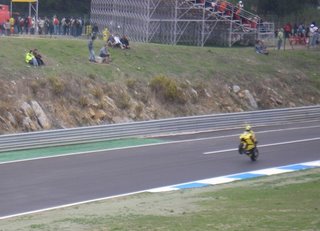 Not that a grandstand ticket gets you a seat - I don't think anyone has heard of overcrowding so the only room was on the grandstand stairs packed in amongst all the Spanish that had ridden across the Iberian peninsula for the day.
Not that a grandstand ticket gets you a seat - I don't think anyone has heard of overcrowding so the only room was on the grandstand stairs packed in amongst all the Spanish that had ridden across the Iberian peninsula for the day.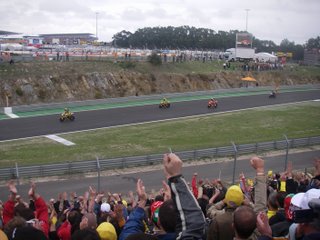 I've always thought motorbike riders/enthusiasts were a close-knit, passionate breed but the intensity of feeling here surprised me. One guy next to me practically sulked when his favourite rider crashed out. I tried to mimic the same emotion when the lone Aussie crashed out but just couldn't match his passion. Or that of the young Valentino Rossi fans below anxiously hoping he can regain front position towards the end of the race.
I've always thought motorbike riders/enthusiasts were a close-knit, passionate breed but the intensity of feeling here surprised me. One guy next to me practically sulked when his favourite rider crashed out. I tried to mimic the same emotion when the lone Aussie crashed out but just couldn't match his passion. Or that of the young Valentino Rossi fans below anxiously hoping he can regain front position towards the end of the race.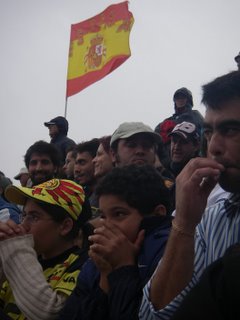
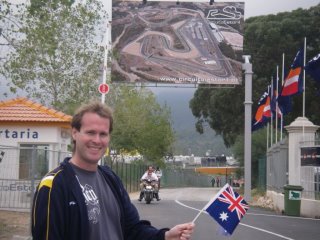

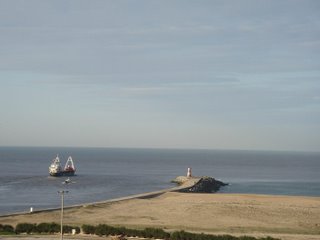 Figueira is an old port and fishing village (Foz means "where river meets sea") which is now a summer retreat full of holiday homes and apartments empty for 11 months of the year. On autumn weekends like this its a little empty making it easier to find a place to have a beer overlooking the sea and watching the sunset or find a spot on the beach (theres 900m of sand between sea and the road so I wouldn't have thought it was too much of a problem!).
Figueira is an old port and fishing village (Foz means "where river meets sea") which is now a summer retreat full of holiday homes and apartments empty for 11 months of the year. On autumn weekends like this its a little empty making it easier to find a place to have a beer overlooking the sea and watching the sunset or find a spot on the beach (theres 900m of sand between sea and the road so I wouldn't have thought it was too much of a problem!). Perthites might consider wandering down to Scarborough on the weekend and doing a "Compare and contrast" with that photo. The sun sets into the ocean just the same. Theres the same single high-rise, the same row of apartments, the same expanse of beach, a walking path alongside it for a jog or a bike ride and the same road along the beach for people run into each other when they look at the view (sunset or joggers ;) instead of the road. Theres even the same stupid clock-tower, except the Figueira one actually chimes the hours, along with the first few bars of the regional anthem. By midnight you're ready to break the speakers. In fact it was broken for a year and I suspect the guy that fixed it has had to leave town.
Perthites might consider wandering down to Scarborough on the weekend and doing a "Compare and contrast" with that photo. The sun sets into the ocean just the same. Theres the same single high-rise, the same row of apartments, the same expanse of beach, a walking path alongside it for a jog or a bike ride and the same road along the beach for people run into each other when they look at the view (sunset or joggers ;) instead of the road. Theres even the same stupid clock-tower, except the Figueira one actually chimes the hours, along with the first few bars of the regional anthem. By midnight you're ready to break the speakers. In fact it was broken for a year and I suspect the guy that fixed it has had to leave town. 